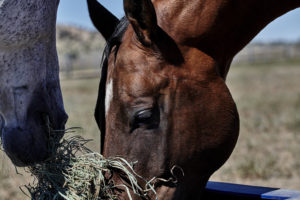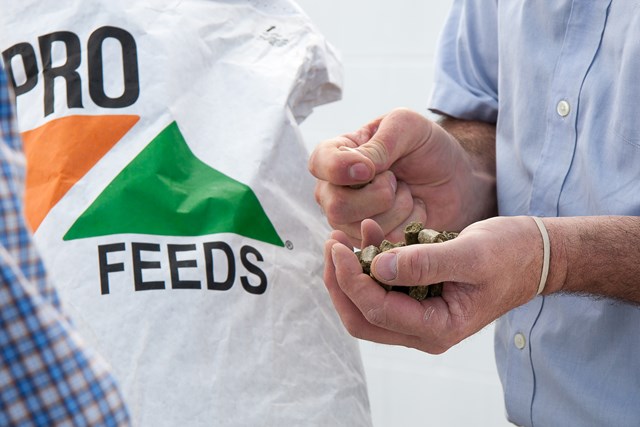By Matt McMillan, Ph.D., Equine Nutritionist, Hi-Pro Feeds
Colic in horses can be defined as exhibiting signs of distress caused by abdominal pain and is one of the most frequent causes of emergency treatment annually and is reported as a leading cause of death in horses in the United States. Further, studies indicate that approximately 9 out of every 100 horses in the U.S. will exhibit signs of colic every year and it is the leading reason for surgery among horses. Also, it has been estimated that between 6 and 11% of horses with colic will die every year. Therefore, understanding the causes, signs, and symptoms of colic to aid in the treatment and prevention of the disease is extremely important.
Causes of colic may be easily identifiable, or may be complex, misunderstood, or unknown. Inside the body of the horse, abdominal pain creating the colic situation may originate anywhere in the gastrointestinal tract or sometimes even outside the gastrointestinal tract. Origins of pain due to colic may be caused by spasms within the G.I. tract, obstruction caused by feed or other foreign objects in the G.I. tract, temporary paralysis of the G.I. tract, displacement or strangulation of the G.I. tract aka twisted gut, enteritis or inflammation of the G.I. tract, ulcers, pregnancy, excessive gas, rhabdomyolitis or tying-up syndrome, liver disease, renal/bladder disease, dehydration, or other factors known or unknown. Environmental causes leading to the increased incidence of colic include diet type, quality, amount and feeding regimes, presence of parasites, age, breed, sex, management, weather, previous medical history as well as other known or unknown factors.
Signs and symptoms of colic include the displaying of many forms of discomfort. Horses who are exhibiting signs of colic may appear restless and/or agitated. If horses are normally stalled or kept in traps or paddocks, they may walk in small circles or more commonly lie down. Lying down will sometimes accompany rolling in an attempt to alleviate pain, which could become very detrimental due to the potential to create a displacement or strangulation of the G.I. tract, which could lead to surgery in an attempt to save the horses life. Sometimes during colic, horses will sweat, have a change in appetite or completely stop eating and may pass less manure. Horses may also paw, kick at their belly, or stare at their flanks. Horses in pain due to colic or other sources of pain, will many times stand with their heads lowered, looking dull or depressed. Clinically, horses exhibiting signs of colic may have an elevated heart rate and/or respiration rate. The ability to recognize these signs and symptoms of colic is important so that proper steps may be taken to treat the colic situation.

While colic may be caused by many different factors known or unknown, good management practices at the very least may help decreases the chances of colic occurring. First thing to consider when managing the horse is to understand how Mother Nature intended the horse to live and thrive. With that considered, horses were meant to consume small amounts of forages all throughout the day with their heads down close to the ground while also constantly moving around as they graze having access to adequate daily water. While in many circumstances, our modern day horses are not able to live this way, we can still try to provide good quality and quantity of forage as the foundation of the horses diet while also providing some type of daily exercise and access to good, clean, fresh water. Quality forage can come in the form of pasture, hay, or forage cubes at a rate of at least 1.5% of the weight of the horse. Since our modern day horses have increased energy, mineral, and vitamin needs among other nutrients, fortified grain rations need to be provided in addition to forage. However, it is important to note, that no more than 5 pounds should be fed at one time. If the horse requires more than 5 lbs per day, 2 or 3 meals should be provided throughout the day. These grain rations may also provide beneficial ratios of nutrients indicated by research such as amino acid and fatty acid profiles that are not provided through forage alone. Additionally, grain rations can provide additional supplementation to aid in the reduction of colic by increasing gastrointestinal health by helping to reduce pathogen loads, bind potential toxins in the G.I. tract, increasing beneficial bacteria, increasing buffering effects in the hindgut, increasing availability of nutrients to be synthesized in the body, providing substrates to aid in increased antioxidant activity, and helping in the overall digestion process to ultimately increase overall health. Further, good, clean, fresh water should always be available to try to maintain good water intake. While automatic waterers are convenient, water consumption may be difficult to monitor and decreased water intake may not always be recognized. Also, proper de-worming schedules are also important to aid in the prevention of colic along with introducing new feeds slowly so that horses can adjust properly. Lastly, if horses are to be fed in herds, it is important that enough feed pans or bunk space is available and that pecking orders are monitored so that all horses are able to eat evenly. While colic can occur in even the most carefully managed horses, management practices can help to prevent many situations.
If horses begin to exhibit signs of colic, it is suggested to call a local veterinarian immediately. To help reduce the chances of colic, good management practices should be in place daily. To find a good quality fortified forage and/or grain source contact Hi-Pro Feeds or take a look at our products page.


